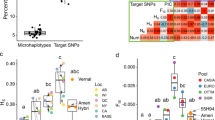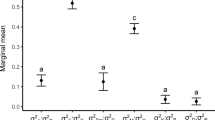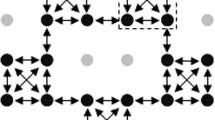Abstract
Plants of a self-incompatible species, which occur in small populations, may have reduced fitness due to the limited availability of compatible mates. Self-incompatibility decreases inbreeding by allowing successful mating to occur only with individuals which differ by at least one-allele at the S-locus. A computer simulation model was developed to test the effect of small population size upon the diversity and the relative frequency of the S-alleles which determine the number of available mates. In a large population at equilibrium, the greater the number of S-alleles the greater the frequency of available mates for all individuals in the population. In small populations (less than 50 individuals), they are unable to maintain a high diversity of S-alleles and therefore there is a decrease in the frequency of available mates. In addition, in small populations there is an increase in the variance of available mates. The number of mates in these populations depends on the genotype of a particular individual. Two patterns would be expected in a small population of incompatible species: (1) a lower seed set per individual due to limited mates, and (2) an increase in variation of seed set among individuals due to the variance in available mates. Lower seed set would lead to a decrease in fitness of particular genotypes and could increase the possibility of local extinction of the species.
Similar content being viewed by others
Article PDF
References
Charlesworth, D. 1988. Evolution of homomorphic sporophytic self-incompatibility. Heredity, 60, 445–453.
De Nettancourt, D. 1977. Incompatability in Angiosperms. Springer-Verlag, Berlin.
Ellstrand, N C, and Levin, D A. 1980. Recombination system and population structure in Oenothera. Evolution, 34, 923–933.
Emerson, S. 1940. Growth of incompatible pollen tubes in Oenothera organensis. Bot Gaz, 101, 890–911.
Gottlieb, L D. 1973. Genetic differentiation, sympatric spec-iation, and the origin of a diploid species of Stephanomeria. Am J Bot, 60, 545–553.
Imrie, B C, Kirkman, C J, and Ross, D R. 1972. Computer simulation of a sporophytic self-incompatibility breeding system. Aust J Biol Sci, 25, 343–349.
Imrie, B C, and Knowles, P F. 1971. Genetic studies of self-incompatibility in Carthamns flavescens Spreng. Crop Sci, 11, 6–9.
Jennersten, O. 1988. Pollination in Dianthus deltoides (Caryophyllaceae): Effects of habitat fragmentation on visitation and seed set. Conserv Biol, 2, 359–366.
Kowyama, Y, Shimano, N, and Kawasi, T. 1980. Genetic analysis of incompatibility in the diploid species of Ipomoea closely related to the sweet potato. Theoret Appl Genet, 58, 149–155.
Lande, R. 1988. Genetics and demography in biological conservation. Science, 241, 1455–1460.
Lindkvist, A. 1979. One-locus sporophytic self-incompatibility in the carnation family, Caryophyllaceae. Hereditas, 91, 307 (Abstract).
Levin, D A. 1978a. Genetic variation in annual Phlox: self-compatible species. Evolution, 32, 245–263.
Levin, D A. 1978b. Some genetic consequences of being a plant. In: Brussard, P. E. (ed.) Ecological Genetics: The Interface, Springer-Verlag, New York, pp. 189–214.
Levin, D A, Ritter, K, and Ellstrand, N C. 1979. Protein polymorphism in the narrow endemic Oenothera organensis. Evolution, 33, 534–543.
Lloyd, D G. 1965. Evolution of self-compatibility and racial differentiation in Leavenworthia (Cruciferae). Contr Gray Herb, 195, 3–134.
Martin, F W. 1968. The system of self-incompatibility in Ipomoea. J Hered, 59, 263–267.
Mayo, O. 1966. On the problem of self-incompatibility alleles. Biometrics, 22, 111–120.
Richards, A J. 1986. Plant Breeding Systems, Allen and Unwin, London.
Sampson, D R. 1974. Equilibrium frequencies of sporophytic self-incompatibility alleles. Can J Genet Cytol, 16, 611–618.
Solbrig, O T. 1972. Breeding system and genetic variation in Leavenworthia. Evolution, 26, 155–160.
Soule, M E. 1987. Viable Populations for Conservation, Cambridge University Press, Cambridge.
Sullivan, V I. 1972. Investigations of the breeding systems, formation of auto-and alloploids on the reticulate pattern of hybridization in North American Eupatorium (Compositae). Ph. D. Thesis Florida State University, USA.
Thompson, M M. 1979. Genetics of incompatibility in Corylusavellana L. Theoret Appl Genet, 54, 113–116.
Wilson, E O. 1988. Biodiversity, National Academy Press, Washington D.C.
Wright, S. 1960. On the number of self-incompatibility alleles maintained in equilibrium by a given mutation rate in a population of given size: a reexamination. Biometrics, 16, 61–85.
Wright, S. 1964. The distribution of self-incompatibility alleles in populations. Evolution, 18, 609–619.
Wright, S. 1969. Evolution and the Genetics of Populations. Vol. 2 The Theory of Gene Frequencies. University of Chicago Press, Chicago, IL.
Author information
Authors and Affiliations
Rights and permissions
About this article
Cite this article
Byers, D., Meagher, T. Mate availability in small populations of plant species with homomorphic sporophytic self-incompatibility. Heredity 68, 353–359 (1992). https://doi.org/10.1038/hdy.1992.50
Received:
Issue date:
DOI: https://doi.org/10.1038/hdy.1992.50
Keywords
This article is cited by
-
Gametophytic self-incompatibility in Maxillariinae orchids
Protoplasma (2024)
-
Reproductive Biology of Asteraceae on Oceanic Islands
The Botanical Review (2023)
-
Floral biology of two woody species of Dalbergia at high risk of timber extraction
Brazilian Journal of Botany (2022)
-
Developing self-compatible diploid potato germplasm through recurrent selection
Euphytica (2021)
-
Strong genetic differentiation on a small geographic scale in the Neotropical rainforest understory tree Paypayrola blanchetiana (Violaceae)
Tree Genetics & Genomes (2020)



